Golf SE Conquers 29 Below, Guided by Wolf Moon
Filed under: Weekly test drives, Autos
BEMIDJI, MN.
People in Chicago, or Detroit, or Minneapolis, always nod and say they know what you mean when you say it’s cold in Northern Minnesota. But they don’t. They think “cold” means it was uncomfortably cold, maybe zero, or 10 above, which can be uncomfortable, all right.
Then there’s Bemidji, Minnesota. Paul Bunyan Land, we’re told, and the gigantic statue of Paul and Babe the Blue Ox, which greets you as you enter Bemidji from the south, is their emblem, standing there rigidly on the shores of Lake Bemidji. They are rigid, because it’s 29 below zero outside on this bright and sunny morning in January. Twenty-nine. And we’re not talking wind-chill here, it was minus-29 actual.
Perfect conditions for a test drive of the 2019 Volkswagen Golf SE, a new model to add to the impressive collection of Golf small sedans. We used to be able to say coupes and sedans, but VW decided not to bring even the GTI 2-door to the U.S. this year, so the hot-rod GTI with all its fantastic handling and power comes only as a 4-door.
Of course, there are other Golf models, including the Golf R, which is an all-wheel-drive version of the GTI, and there is the SportWagen, an actual sporty station wagon based on the Golf platform. The Jetta, which began life as a 4-door-with-trunk version of the Golf hatchback, is now separate, although with the same new platform and a unique 1.4-liter turbocharged 4-cylinder at the base of its powertrain. As a group, Motor Trend named the redesigned Golf as its Car of the Year for 2018.
When I heard the vehicle that would be delivered to me in Duluth, Minnesota, would be the new Golf SE, I was more than just interested. After all the big changes for 2018, there were only some minor alterations for 2019, but among them is that VW has taken the 1.4 and put it into two Golf models — the base S and the nicely upgraded SE. Having driven that engine in the Jetta, and being very impressed, it seemed silly that it wasn’t already put into the Golfs, but what did I know?
Well, I knew that as amazingly consistent and strong as the 2.0 and its 1.8 derivative have been over the years, that the 1.4 is from an all-new engine family, and is even more efficient than the redoubtable 1.8 and 2.0.
My wife, Joan, had been planning on driving across to the western end of Minnesota to visit her sister, who was celebrating her birthday in Fergus Falls, so I came up with the ideal compromise. We could drive up Hwy. 2 from Duluth to Bemidji on Friday, stay overnight, and drive south to Fergus Falls on Saturday afternoon, in time to take everybody out to dinner.
The intriguing part of my plan is that the Minnesota Wild and Fox Sports North television have been collaborating for several years on what they call Hockey Day Minnesota. They set up an outdoor rink in a selected town, then they coordinate to spend the whole day putting on return-to-your-roots hockey games between boys and girls high school teams and a couple of college games for good measure, and get the whole thing done in time for the Saturday night Wild game back in the warm confines of Xcel Energy Center in Saint Paul Read more
Sporty Edge ST Features Can Fool You
Filed under: Weekly test drives, Autos
The fellows who carry out the delivery and pickup of test-drive vehicles to auto journalists who drive, evaluate and report on those new cars do an amazingly efficient job, making sure the vehicles are clean, fueled and ready to be driven. But sometimes extenuating circumstances can get in the way.
When I got a 2019 Ford Edge ST for a week, it happened to coincide with what might have been the harshest week in the harshest January winter weather to hit Minnesota in at least a couple of decades. The car washes were all closed up, wisely avoiding the 20-below temperature.
The week was long and cold, with heavy snow accenting the sub-zero plunge, and while none of that prevented me from fully appreciating the Edge’s new sportiest model, I had spent most of the week exploiting all the features and appreciating them greatly as we eased through the endless days of nasty weather.
We appreciated the firm chassis, and the upgraded suspension of the ST, and we also noted almost daily, sometimes more than once a day, how swiftly the seat heaters and heated steering wheel seemed to warm up. Some vehicle have heated seats but it seems like you have to drive 5 miles before you feel any warmth. Not the new Edge. It seemed like 8 or 10 blocks and you were feeling cozy through the seat cushion, which is welcome while you wait for the customary heat buildup.
On that start-up front, we also thoroughly appreciated the auto-start, wherein you remotely lock the doors, then hit the proper button on the key fob and the car starts itself. Good for a brief engine warm-up, and also good for getting a head start on loosening up the glacial deposits on the front and rear windows for a quick clearing.
I was getting a little curious, though, because everything about the Edge ST was so impressive, I wondered if we might find at least a nitpick to balance all the superlatives. We couldn’t complain or praise the “Performance Blue Metallic” exterior paint, because even though our older son, Jack, mentioned what an impressive shade of blue it was, we couldn’t really prove it, located as it was under this weeklong buildup of snow/salt/road-glop that we had not been enjoying.
Finally, the temperature crept up to 15 degrees last Saturday, and I took a chance. Sure enough, the coin-operated car wash on the eastern edge of Duluth, Minnesota, had taken down its boldly lettered “Closed” sign. I pulled in, and nobody else was risking it, so I flung the door up and pulled inside. I had four $1 bills, which was just enough to get you 4 minutes of heavy soap spray, and then a swift rinse to get rid of all that glop. The timer ticks each second off, and a nasty alarm alerts you that you’re in your final minute, and if you’re smart you’ll add more money so that you don’t wind up with a soapy mess when you finish.
All went well, and in my practiced routine, I went in segments to make sure I didn’t miss the left side, front, right side, and rear with the soap wand. Then I quickly switched to rinse and noted I only had 1:30 left. I took care of the left rear corner, then the left side, then the windshield, hood and left front corner. I knew the time was going, and it was going to be close. Got the black-out grille, the foglight and then the right front fender, right side and on back.
Noticing I only had about 30 seconds left, I hustled, and started rinsing the rear hatch. Moving from right to left, I had just reached the far left side when a sudden little noise startled me, and the entire hatch started to flip up. I tried to change hands and push it back down, but it was resisting. I continued around the left rear corner and the water stopped. Out of time.
Hanging up the wand and tubing, I couldn’t resist shooting one photo in the foggy, muggy car wash with the hatch open. Of course, I realized quickly what had happened. The new war of features that Ford has so energetically engaged in has led the company to come up with a slick thing to aid those carrying grocery bags or armloads of luggage to stow, allowing the hatch to release and spring open just by waving your foot under the rear bumper. If you have the key fob in your pocket, the hatch opens. Read more
Accord Hybrid Over-Runs Demands of Family Sedan
Filed under: Weekly test drives, Autos
By John Gilbert
BELLINGHAM, WASH.
My first after-Christmas auto review was going to be on the 2019 Honda Accord Hybrid, with the spectacular backdrop of the Pacific Northwest and Mount Baker. But that was before I got carried away describing the life-saving performance of our family Mini Cooper, making it home from Minneapolis to Duluth in a 6-hour battle against ice and whiteout conditions.
There’s still time. We can go back and evaluate the Accord Hybrid, but I must admit to being distracted by the spectacular scenery. No, not distracted driving; we stopped to admire the breathtaking views.
Without a doubt, the new Accord makes a strong impression, whether looking at it, riding in it, or driving. The EPA estimates for gas mileage is 47 miles per gallon city, 47 highway, and 47 combined. Makes sense. The Accord also performs with a strong, sporty flair that parallels the new looks.
The tenth generation Honda Accord came out as a 2018 model, and it is a curvaceous, attractive sedan that seems bigger than midsize. With styling cues from the exotic NSX sports car, the virtually unchanged 2019 stops folks in their tracks with its looks, especially from the front, where its thin string of LED headlights underscores the exotic appearance.
You could say this isn’t your daddy’s Accord, except that I was playing the daddy role during the trip.
I got a chance to test drive the new Accord Hybrid on our family’s Christmas trip to the Seattle-Bellingham areas of Washington, and several things jumped out at us immediately. First, there is enough room in the rear seat to hold a small convention, and the roominess is better than some large cars.

Stunning sunsets illuminate the shadows of Bellingham’s harbor and the San Juan Islands off to the West.
Second, there is considerable power from the hybrid system, which has a combination of a 2.0-liter VTEC 4-cylinder engine and a rechargeable electric motor device that, combines, produces 212 horsepower. I have no doubt the Accord Hybrid could have handled our venture from Bellingham up to the ski stations at the top of Mount Baker, but since the area had just been hit by over 2 feet of snow, we would be wiser to make the trek in younger son Jeffrey’s 4×4 Tacoma pickup.
The third noteworthy feature was that Honda is going with a continuously variable transmission, an electrically operated unit that uses belts and pulleys to enlarge or diminish in a system of never-shifting but always-shifting. CVTs have the nagging tendency of droning like a one-speed outboard instead of the stepped peaks of a normal automatic transmission. Honda wisely adds paddle shifters on the steering wheel to allow the driver to simulate manually controlled shifts and alleviate some of that inherent boredom.
I would grade Honda’s effort at B-, for at least trying to make it sporty.
The best part of a hybrid is to approach the spirit of a gasoline engine and provide a large increase in fuel economy from the electric motor input, knowing that the gas engine can spend its spare time recharging the electrical power.
Going back a couple of decades, to when Toyota and Honda were ferocious rivals to establish the major footprint on the hybrid market, Toyota had the Prius and Honda the Insight, and both tried to figure out how to turn their immensely popular midsize sedans into hybrids, so Honda put its system into the Accord, ahead of Toyota putting its system into the Camry.
It was fun talking to engineers of both companies, and I recall attending the earlier Accord Hybrid introduction when I questioned the engineers about why — when the gas engine’s primary duty is to recharge the battery pack — Honda didn’t use its exceptional 4 instead of the larger V6. They had their reasons, but I followed by asking what would happen if Toyota used its 4 with the hybrid when the Camry came out. That’s what happened, and when the Camry flashed better fuel economy, Honda was quick to discontinue the Accord Hybrid.
Hybrid technology has advanced all along, and the newest hybrids are remarkable in their smoothness and performance. Plug-in hybrids are even more efficient, and a logical step up as we transition toward all-electric vehicles. German hybrids from Audi, BMW and Mercedes have made their mark, and Hyundai has made amazing strides with among the highest technology in hybrids with the Ioniq and Sonata sedans, and the new Kona CUV.
Honda’s strategy is to bring out a newly designed Insight, while powering the rear wheels of its exotic NSX with electric motors, and bring back the Accord as a hybrid model. Most impressive, given that history, is that the new 2019 Accord Hybrid uses the potent corporate 2.0 4-cylinder engine to work with the electric power.
Because hybrid power is most efficient in stop and go traffic, city miles per gallon is usually higher than highway cruising — the opposite for gas-engine driving. Driving moderately can keep the gas mileage up near that magical 50 mark, and you certainly could top it with extra care.
When driving a hybrid, you want to let off the gas before needing to clamp hard on the brakes, and easing the brakes on for a slow stop enhances the recharging characteristics. Same with going down hills. In Duluth, for example, you might use a lot of available power zooming up the hills, but you also can recover a lot by braking lightly as you come back down.
The next most impressive thing about the Accord Hybrid is that it comes in a pretty loaded form, so no added options were necessary on our test vehicle, which had a bottom-line sticker of $35,605, decidedly reasonable because the standard roomy Accord sedan would cost just about the same, with the same features.
Those features include all the current items: rear camera, cross-traffic alert, lane keeping and lane departure assist, road-leaving mitigation, collision mitigation, remote start, front and rear parking sensors, and adaptive cruise. And it also adds some features that are pretty unique. Twelve-way power driver seat should keep you alert, but there also is a driver attention monitor to help keep you tuned in. Another is “walk-away locks,” which I wasn’t familiar with. But when we left the car unlocked briefly and came back to find it had locked itself, I was impressed. Honda always has been adept at unobtrusively making cars idiot-proof.
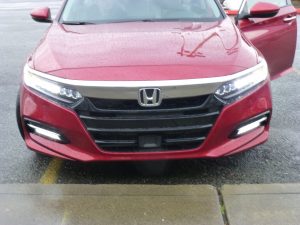
New-generation style, plus increased air-intake for hybrid engine cooling give Accord a distinctive look.
Honda always has been at the forefront of great handling and steering, too, and the Accord Hybrid takes that to a new level, with firm suspentsion and precise, line-carving trajectory around curves making full use of the well-tuned MacPherson strut front and multi-link rear suspension, and proving it is possible to coordinate electric steering and shift control.
It would take longer than we had to get comfortable with tuning tricks for the audio system, where Honda seems to have subscribed to rivals who make the simple tasks that used to be operated by round knobs for volume and selection needlessly complex.
Wherever you look, though, you realize that if you just bought a contemporary, roomy 4-door sedan, you could pay $35,000; if you bought a different vehicle with a contemporary hybrid system, you could easily pay $35000. The Accord Hybrid gives you both — a roomy super-sedan that is quick and handles well, and a hybrid powertrain that meets all requirements and delivers exceptional economy.
Good ‘Ol Mini Weathers the Worst Weather
Filed under: Weekly test drives, Autos
‘Twas the night after Christmas — OK, second night after Christmas — and all through the windblown snow not a creature was stirring on Interstate 35 between Minneapolis and Duluth, except for about a dozen other souls who had the same need to get there as we did.
Those others were in new pickup trucks or SUVs, mostly, and my wife, Joan, and I were in our trusty 2007 Mini Cooper, which has been our beloved companion for a decade and which has never let us down.
But this time was different. This time we were setting out from the Minneapolis-St. Paul International Airport at 11 p.m. for what would normally be a two and a half hour drive. Maybe three. But if you recall the second day after Christmas this year, it rained in the Twin Cities, which equated to about 15 inches of nasty, windblown, crusty snow on the North Shore outside of Duluth, and the trip from the Twin Cities to Duluth displayed every mixture of the rain/snow extremes, as Mother Nature seemed intent on playing tricks on anyone foolish enough to drive through it.
Driving new cars is a pure joy, even when the evaluation process might add a harness on the outright pleasure I could otherwise derive from test-driving the newest vehicles from any and all manufacturers. I also have always loved the adrenaline high of driving through the worst possible winter conditions.
As challenging and enjoyable as it is to drive the newest cars through all conditions, there is no doubt that the idea of owning a car means it must have all the attributes of a good Boy Scout — friendly, trustworthy, honest, loyal, thrifty, and all that.
Driving a car for a decade or so is one thing, and it is diametrically opposed to the switching from one new vehicle to another week after week for Newcarpicks test-drive reviews. Our family has found a reasonable solution, and that is to own a car that will work for the long haul. Joan generally does most of the driving in that vehicle, while I continue to test-drive new stuff, always encouraging her, and my sons, to also try the new cars and give me varied feedback.
At Christmas this year, we did what we’ve always wanted to do but have never before accomplished. I gathered up enough Delta SkyMiles coupons to get three round-trip tickets for Joan, our older son Jack, and me, to Seattle and back, to spend Christmas with our younger son, Jeff, in Bellingham, Washington.

Atop Mount Baker, the Gilbert Clan gathered: Joan, Jack, your faithful author, and selfie-shooter Jeff.
After talking over the most reasonable and efficient ways to pull it together, Joan and I decided to drive our 2007 Mini Cooper to pick up Jack on the way and head for the MSP air terminal. We did it and, thanks to Park and Go, we secured the car and got shuttled to the airport. It was a quick trip, as it always seems to be when you get your family together. The plan came about because Jeff was house-sitting — and mainly dog-sitting — for a good friend’s family, and they suggested inviting us out to stay at their place as well.
Wonderful time, with time to think amid the clamoring of the three household dogs. We’re getting to the age when we’ve stopped bugging our sons to get married and start families of their own. Apparently they’re having too much fun being single. But because of the unusually high number of close friends who have met untimely deaths in the past year, we need to savor every opportunity we have for the four of us to spend time together.
We enjoyed seeing the sights of Bellingham, with the seaside sunsets to the West and the majestic Mount Baker to the East, and Jeff showed off his new Tacoma pickup by driving us to the top of the Mount Baker ski area, where we had a great lunch and more sightseeing. They went from not having enough snow to being dumped on for about a 3-4 foot base now.
The dogs were predictably crazy. The big one, Nova, a mixture that resulted in her looking a lot like the old RCA Victor dog, had been around the two tiny dogs — Beckham and Barbara — so much we think she thought she was a lot smaller than she is, and could play too rough with her adopted siblings. But we enjoyed them, with room to let them run every day.
When it came time to leave, Jeff went off to work, and we said our good-byes to the dogs, locked up, and hi tthe road for Seattle, a couple of hours away. All went well, but I had seen the forecast on my trusty iPhone’s weather app. We landed at MSP and got shuttled to our car and the driver told us it had snowed early, but then just rain, which washed away most of the snow. We loaded everything into the Mini’s astoundingly spacious capacity and headed up I-35E. After we dropped Jack off at his house, the rain had turned to what they call a “wintry mixture,” and by the time we got up to North Branch, it was snow, blowing horizontal.
I noticed the Mini’s tiny engine never hesitated, but I also noted that our Nokian WGR-3 tires must be showing signs of age, because the car’s front end wanted to wander a bit. That is not a good thing, on an icy and snow-covered surface.
At North Branch, we found ourselves behind two plow-trucks who were running side by side at about 35 miles per hour. That was fine with us, although a couple of aggressive drivers passed us and seemed impatient to go that slowly. The plow trucks exited at Pine City, and we were on our own. We were particularly on our own when the three or four cars that had been with us all took off and disappeared in a cloud of blowing snow.
My sons both messaged us, urging us to stay at Jack’s, or at an inexpensive motel, but we wanted to get home — and to make a true confession here, I actually love to drive in severely harsh winter storms. That’s foolhardy, but ever since I learned to drive in winters on the Duluth hillsides, the adrenaline high I feel from the mandatory sharpened and heightened senses makes for a weird sense of achievement.
This was different, however. I apologized to Joan, because when she said she thought our tires might be wearing out, I scoffed that nearly worn-out Nokians were probably better than newer other tires. Curiously, the next day I stopped to see Jeff Hofslund at Foreign Affairs and told him of my concern, and that I was betting we’d gotten those tires five years ago. He looked it up on his slick computer and found that one day earlier was the five-year anniversary or our purchase of those tires. Driving them winter and summer, for about 50,000 miles, certainly had lessened their effectiveness.
That, of course, was after the fact. During the drive, we found no other cars out. The few who had driven off ahead were gone, and we never caught up to any others, and only two or three cars eased up behind us and passed, soon disappearing.
We didn’t keep up because the front end was wandering a bit, feeling like the bow of a speedboat in rough water. This wasn’t rough, it was completely smooth, but it also had a thorough covering of snow over the ice base underneath. We were driving with no lines visible, no side lane lines, no dotted center line, and no other tracks, with the passing cars tracks swiftly covered over.
Joan drifted off to sleep, assured that I was riveted to the task at hand, and I was glad she did. At least one of us could rest. The challenge of driving through what amounted to complete whiteout conditions presented interesting problems.
For example, there was no way to tell how much room there was on either side between the Mini and the edge of the road. So a few times, I eased over to the right until my tires caught the corrugated warning line for lane-departure, then I could ease back to what I figured was the center of the two lanes.
I glanced at the clock on the Mini dashboard and it said 3:30, and we were a long way from home yet. When I got near the Cloquet exits, I knew we were almost there. Coming down Thompson Hill, another car approached from behind, apparently unaware of the icy coating under the snow on the freeway. We pulled over and let him go.
The biggest challenge was yet to come. I headed out onto the highway heading East out of Duluth, and got to our road. All that was left was two miles of a long incline and we’d be safe and at home. However, it was obvious that the road had been plowed, but it had to be hours earlier, and it surely needed another plowing. What was left was a crazy pattern of rough, rugged lanes carved by tires to leave hard ridges about a foot high running longitudinally like ribbons
The poor Mini was churning onward and upward, with the front end, led by the license plate, actually plowing up snow that flew over the hood. I kept going, and as we headed up our final hill, the traction-control warning light flashed repeatedly, meaning we were spinning more than we were moving. We made it up most of the final hill, but the spinning increased and the movement decreased, right up until we were sitting motionless in the middle of our road. I backed down, carefully, and tried again, but the same thing happened again.
Then I had an idea. I backed down to the bottom or our hill, where I trusted that a neighbor across the road might be plowed out. He was. So I swung the rear end into his driveway and backed in. Then I pulled out, carefully, aimed down the road. At that point, I shifted into reverse and started calmly and smoothly to back up the hill.
Now, front-wheel drive is good for almost every driving condition, but going up a hill, there is a slight weight transfer from front to rear, lifting the downforce from the front drive wheels. So when you back up, any weight transfer goes to the front end, where more weight it a benefit over the drive wheels.
Sure enough, I backed up the hill, watching carefully to see if any headlight glow ight be approaching, but there was none. Our neighbors are smarter than to venture out in those conditions. I kept backing up, closer and closer to our driveway, until I could back through the final 90-degree turn and make it. I backed in about two-thirds of the way into the driveway our neighbor had graciously tried to plow into the 15-inch depth that was there.
We climbed out, carried all our luggage, and made it into the house, warm and secure as it awaited our arrival. It was 5:30 a.m., and the trip that I have often made in a bit less than 3 hours had taken 6 and a half hours.
Both of our sons stayed up all night, texting Joan to check on our progress. They couldn’t believe we made it, and they couldn’t believe how long it took us. They are both great people, but, of course, I’m prejudiced. There’s also a sensitivity factor involved. As we were leaving for the Seattle airport, Jeff had already left for work. We all gave each dog a final petting, and I must admit that they could be nuisances for much of the time we were there, but we had become attached in four days. In fact, when Jack made his final rounds of petting, I detected a tear in his eyes at the sadness he felt for leaving those dogs.
And now we were home. It occurred to me, though, that the severe spinning I encountered trying to make our hill might have been an indication that I had caused some damage to the transmission, and that it was the transmission slipping rather than the tires. Worrying about that, I also realized we had to make it, as matter of survival with each passing mile. We had to trust the Mini to carry us home, and it did.
At about noon, I ventured out to shovel my way to the car, worrying that there might be some damage to assess. I started it up, and it sprung to life. By then the roads and highways had been completely plowed, and I drove smoothly out onto our road, down the hill, and onto the freeway heading into Lester Park. I took it up to Foreign Affairs just to be reassured, and Jeff Hofslund laughed and said he knew the car would do the job, because he, too, owns one, which his wife likes so much she won’t let him sell it or trade it in.
If those rugged foot-high ruts of ice-hardened snow had broken something on the underside of the Mini, we would have had to consider it a necessary problem for getting home. I made an appointment to get some new tires, and an oil change, because the Mini was tougher than Old Man Winter’s icy blast. But it seemed the Mini had healed itself.
Because I rarely drive the car, I hadn’t realized there was a tiny little button on the console, just behind the shifter, where a driver couldn’t possibly see it. It was a button to engage the traction control. All the flashing lights I noticed blinking as we swayed on the icy freeway were blinking to notify me I was driving with the traction control inadvertently disengaged! I was blaming those aged Nokians and the Mini itself, and now I realize both were blameless. A less-clueless driver might not even have lost traction.
Still, getting it thoroughly checked is the least we could do to pay the Mini back for such superb loyalty. And maybe we’ll get a dog.



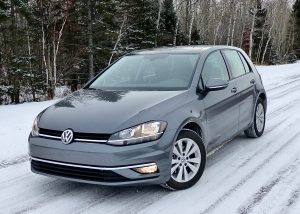
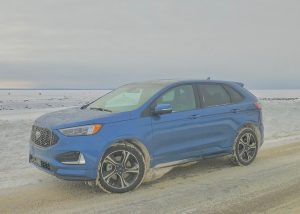
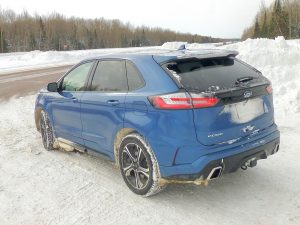
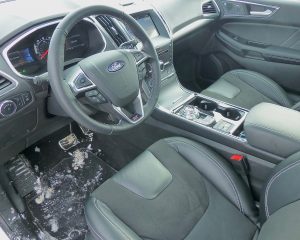
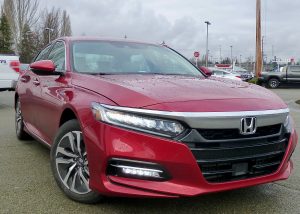
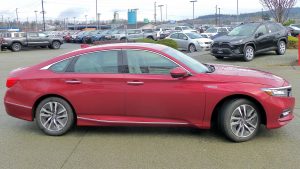
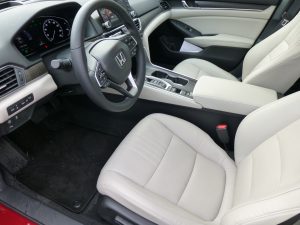
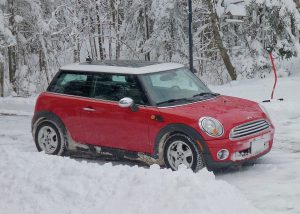


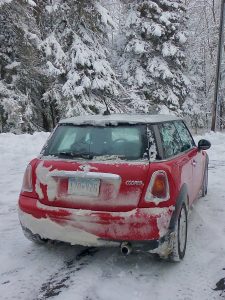


 John Gilbert is a lifetime Minnesotan and career journalist, specializing in cars and sports during and since spending 30 years at the Minneapolis Tribune, now the Star Tribune. More recently, he has continued translating the high-tech world of autos and sharing his passionate insights as a freelance writer/photographer/broadcaster. A member of the prestigious North American Car and Truck of the Year jury since 1993. John can be heard Monday-Friday from 9-11am on 610 KDAL(www.kdal610.com) on the "John Gilbert Show," and writes a column in the Duluth Reader.
John Gilbert is a lifetime Minnesotan and career journalist, specializing in cars and sports during and since spending 30 years at the Minneapolis Tribune, now the Star Tribune. More recently, he has continued translating the high-tech world of autos and sharing his passionate insights as a freelance writer/photographer/broadcaster. A member of the prestigious North American Car and Truck of the Year jury since 1993. John can be heard Monday-Friday from 9-11am on 610 KDAL(www.kdal610.com) on the "John Gilbert Show," and writes a column in the Duluth Reader.